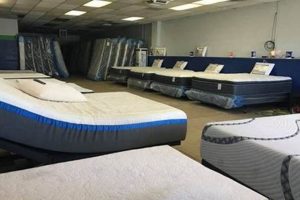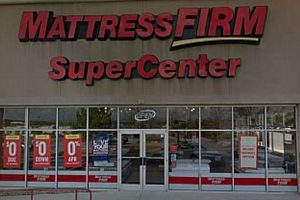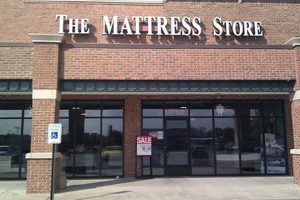The process of safely keeping a bed’s sleeping surface when it is not in use is a critical aspect of maintaining its longevity and hygiene. Improper handling during periods of disuse can lead to damage, which can compromise the comfort and support the mattress provides when returned to service. For instance, storing it without adequate protection could result in mold growth or pest infestation, rendering it unusable.
Proper preservation offers significant advantages, including preventing costly replacements and ensuring a healthy sleep environment. Historically, methods for safeguarding bedding have evolved from simple protective coverings to contemporary techniques involving climate-controlled environments and specialized packaging. Preserving such items, therefore, represents a sound investment in both financial resources and personal well-being.
The following sections will provide a detailed exploration of essential considerations, encompassing preparation steps, suitable storage locations, necessary protective materials, and strategies for long-term maintenance. These guidelines will help to ensure that the sleeping surface remains in optimal condition until it is needed again.
Essential Guidelines for Safekeeping
The following guidelines provide crucial information for effectively preserving a sleeping surface during periods of disuse, ensuring its protection from damage and maintaining its structural integrity.
Tip 1: Thoroughly Clean the Surface: Prior to safekeeping, vacuum the entire surface, including crevices, to eliminate dust mites, debris, and potential allergens. Stains should be addressed with appropriate cleaning agents, ensuring complete dryness before proceeding.
Tip 2: Employ a Protective Cover: Enclose the item in a dedicated mattress bag constructed from durable plastic or breathable fabric. This safeguards against dust, moisture, and potential infestations during storage.
Tip 3: Choose an Appropriate Location: Opt for a cool, dry environment free from direct sunlight and extreme temperature fluctuations. Avoid damp basements or humid attics, which can promote mold and mildew growth.
Tip 4: Maintain a Flat Orientation: The optimal positioning involves laying the mattress flat, as prolonged upright storage can cause shifting and distortion of internal components. If vertical orientation is unavoidable, rotate it periodically to distribute weight evenly.
Tip 5: Elevate from the Floor: Position the item on a pallet or platform to facilitate air circulation and prevent moisture absorption from the ground. This measure significantly reduces the risk of mold and mildew formation.
Tip 6: Avoid Stacking Items on Top: Refrain from placing boxes or heavy objects on the sleeping surface, as this can lead to permanent indentations and structural damage. Maintain a clear and unobstructed area around the stored item.
These steps are vital to ensuring the sleeping surface’s longevity and protecting the investment. Proper implementation of these suggestions will result in a product that remains in usable condition when it is needed.
The subsequent section will address long-term care strategies to guarantee its continued protection.
1. Cleanliness
Prior to long-term containment of a sleeping surface, meticulous cleaning is paramount. This crucial step directly impacts the preservation of the item, mitigating potential degradation and maintaining a hygienic state. Neglecting this phase can result in irreversible damage and health hazards upon subsequent use.
- Removal of Dust Mites and Allergens
Thorough vacuuming eliminates dust mites, dead skin cells, and other allergens that accumulate within the fibers of the material. Failure to remove these particles provides a breeding ground for pests and can exacerbate allergies, diminishing the sleep quality upon reintroduction into service. This directly correlates to the hygiene and health considerations.
- Stain Removal and Prevention of Microbial Growth
Addressing existing stains with appropriate cleaning agents prevents the proliferation of bacteria and mold. Untreated stains can serve as a nutrient source for microbial growth, leading to unpleasant odors and material decomposition. Complete drying post-cleaning is crucial to inhibit moisture-related issues within the enclosed environment.
- Elimination of Odors
Cleaning helps neutralize lingering odors that may be trapped within the material. These odors can intensify during the containment period, rendering the item less desirable for future use. Odor removal contributes to a fresher, more inviting sleeping experience upon retrieval.
- Prevention of Pest Infestation
Residual food particles or organic matter can attract pests such as insects and rodents. Cleaning eliminates these potential food sources, reducing the risk of infestation during the containment phase. This aspect safeguards the structural integrity of the mattress and prevents costly damage.
The facets of cleanliness, encompassing allergen removal, stain treatment, odor elimination, and pest prevention, are inextricably linked to successful mattress preservation. Neglecting these precautions can compromise the longevity and hygiene of the sleeping surface, underscoring the imperative of thorough cleaning before long-term safekeeping.
2. Protection
Safeguarding the sleeping surface against environmental factors and physical damage constitutes a primary element of proper extended disuse handling. Without adequate protection, the integrity of the materials is compromised, leading to reduced comfort, hygiene issues, and a shortened lifespan. The direct consequences of inadequate protection include exposure to moisture, dust accumulation, and potential pest infestations, all of which degrade the condition and render it unfit for future use. A real-life example is a mattress left uncovered in a storage unit, which could become host to mold and mildew after a single season of humidity. Protection, therefore, is not merely a supplementary step, but an integral part of preservation.
Employing specialized mattress bags or covers made from durable, breathable materials offers a multifaceted defense. These coverings shield the material from external elements, preventing the ingress of dust, dirt, and moisture. Furthermore, they act as a barrier against potential physical damage during transport and handling. The selection of appropriate protective materials is therefore a critical decision, directly influencing the effectiveness of the preservation efforts. For instance, a waterproof cover is essential in environments prone to humidity, while a thicker, padded cover might be necessary for situations involving frequent relocation.
In conclusion, protection is inextricably linked to
the successful long-term management of a sleeping surface. The absence of adequate protection leads to predictable and preventable damage. Understanding the cause-and-effect relationship between exposure and degradation is paramount. Prioritizing and implementing robust protective measures represents a fundamental step in ensuring that the mattress remains a viable and hygienic sleeping surface for future use.
3. Environment
The surrounding conditions significantly impact the preservation of a sleeping surface during periods of disuse. Choosing a suitable environment is not merely a matter of convenience, but a critical decision that directly affects the item’s longevity, hygiene, and structural integrity. Adverse conditions can lead to irreversible damage, rendering the sleeping surface unusable.
- Temperature Fluctuations
Extreme temperature swings can cause condensation and moisture buildup within the material. Prolonged exposure to heat can degrade foam layers and adhesives, while freezing temperatures can cause materials to become brittle and crack. A climate-controlled environment with stable temperatures is therefore ideal. A practical example is a storage unit without climate control, where the temperature might fluctuate dramatically depending on the season, accelerating the degradation process.
- Humidity Levels
Elevated humidity promotes mold and mildew growth within the fibers of the mattress. These microorganisms not only create unpleasant odors but also compromise the structural integrity of the material. A dry environment with low humidity is essential to prevent microbial activity. Storing a mattress in a damp basement, for instance, is a common mistake that can lead to extensive mold damage.
- Exposure to Sunlight
Direct sunlight can cause fading and discoloration of the fabric. Furthermore, prolonged exposure to ultraviolet (UV) radiation can degrade the foam layers and other materials, reducing the lifespan of the mattress. A dark, shaded environment is preferable to minimize UV exposure. Storing it near a window without UV protection can result in significant fading and material damage over time.
- Air Quality
Exposure to pollutants, dust, and allergens in the air can contaminate the sleeping surface, reducing its hygiene and potentially causing allergic reactions upon reuse. A clean, well-ventilated environment is essential to minimize contamination. Storing it in a dusty garage or a room with poor air circulation can lead to significant allergen accumulation.
The collective impact of these environmental factors underscores the need for careful consideration when choosing a storage location. Controlling temperature, humidity, sunlight exposure, and air quality is paramount to ensuring the long-term preservation and usability of the sleeping surface. Selecting an appropriate environment represents a proactive investment in maintaining its quality and extending its lifespan.
4. Orientation
The positioning of a sleeping surface during periods of disuse, commonly referred to as its orientation, directly influences its structural integrity and long-term performance. Incorrect orientation can lead to irreversible damage, diminishing comfort and reducing its usable lifespan. Therefore, understanding and implementing proper orientation practices constitutes a vital component of effective storage protocols.
Maintaining a flat, horizontal orientation is generally recommended for most innerspring and foam-based mattresses. This position evenly distributes weight across the entire surface, preventing localized compression and distortion of internal components. Conversely, prolonged storage on its side or end concentrates weight on specific areas, potentially causing sagging, indentations, and compromised support. For example, a memory foam mattress stored vertically for an extended period may exhibit permanent compression along its lower edge, resulting in uneven sleep surfaces upon subsequent use. While vertically storing a mattress could save space, the compromise to its integrity makes it less viable. Careful consideration of support structure must be taken.
The importance of proper orientation extends beyond structural preservation. Maintaining its designed shape and firmness helps prevent issues like back pain and discomfort when the sleeping surface is eventually returned to service. Addressing orientation effectively poses a challenge in space-constrained environments. However, employing techniques like periodic rotation, even during vertical orientation, can mitigate some of the adverse effects of uneven weight distribution. In summary, proper orientation is an essential element in protecting an expensive item, directly affecting its long-term comfort, support, and overall value.
5. Elevation
The practice of elevating a sleeping surface during periods of disuse constitutes a crucial element within effective storage protocols. This seemingly simple measure yields significant benefits, contributing directly to the preservation of the item’s integrity and prolonging its usable lifespan. Overlooking elevation can lead to preventable damage, compromising the material’s hygiene and structural soundness.
- Enhanced Air Circulation
Elevation facilitates unobstructed airflow beneath the sleeping surface, mitigating the accumulation of moisture. Direct contact with the floor restricts ventilation, creating a breeding ground for mold and mildew. By elevating the item, air can circulate freely, reducing humidity levels and minimizing the risk of microbial growth. For instance, a mattress stored directly on a concrete floor in a basement is highly susceptible to moisture absorption and subsequent mold infestation.
- Prevention of Pest Infestation
Elevation creates a barrier against ground-dwelling pests, such as insects and rodents. These pests often seek refuge in dark, undisturbed areas, and direct contact with the floor provides easy access. By elevating the item, the likelihood of infestation is significantly reduced. A mattress elevated on a pallet, for example, is less accessible to rodents than one resting directly on the floor.
- Reduced Risk of Water Damage
Elevating the sleeping surface protects it from potential water damage caused by flooding or leaks. Even minor water exposure can lead to significant damage, including staining, odor development, and structural degradation. Elevation provides a buffer zone, minimizing the risk of water reaching the item. In areas prone to flooding, even a few inches of elevation can prevent costly damage.
- Easier Inspection and Maintenance
Elevation allows for easier inspection of the underside, facilitating early detection of potential problems such as mold, pests, or water damage. It also simplifies cleaning and maintenance, allowing for more thorough vacuuming and removal of debris. A mattress elevated on a frame is much easier to inspect and maintain than one resting directly on the floor, where access is limited.
In summary, elevation is an indispensable practice for effectively storing a sl
eeping surface. By enhancing air circulation, preventing pest infestation, reducing the risk of water damage, and facilitating inspection and maintenance, elevation contributes significantly to the item’s long-term preservation and usability. Integrating elevation into storage protocols represents a proactive measure that safeguards the investment and ensures a hygienic and comfortable sleep surface for future use.
6. No Overload
The concept of “No Overload” is intrinsically linked to effective sleeping surface management during periods of disuse. The practice of storing a sleeping surface must acknowledge the potential for structural damage caused by excessive weight or pressure. Overloading the stored item, either by stacking other objects upon it or by subjecting it to concentrated pressure points, compromises its integrity and reduces its comfort and support capabilities. This is a vital consideration within the comprehensive subject of its storage.
The detrimental effects of overloading are varied and often irreversible. For instance, placing heavy boxes on top of a memory foam mattress can lead to permanent indentations, altering its surface contour and reducing its ability to conform to the sleeper’s body. In the case of innerspring mattresses, excessive weight can damage the coils, leading to uneven support and premature wear. These examples illustrate a direct cause-and-effect relationship: applied pressure leads to structural damage. This connection underscores the critical importance of ensuring no undue burden is placed upon the stored sleeping surface.
In conclusion, the “No Overload” principle is not merely a cautionary note, but a fundamental component of proper storage. Ignoring this aspect can negate other preservation efforts, such as cleaning and protective covering. Maintaining a clear, unobstructed area around the stored mattress ensures that it retains its intended shape and function, thereby safeguarding the initial investment and ensuring a comfortable sleeping surface for future use. The challenge lies in finding storage solutions that accommodate the item’s dimensions without compromising its structural integrity through overloading; careful planning and consideration are essential for success.
Frequently Asked Questions
The following addresses common inquiries concerning the proper management of a sleeping surface during periods of extended disuse. Each question and response provides essential guidance to ensure the item’s long-term preservation and usability.
Question 1: What constitutes the most suitable environment for storing a sleeping surface?
The ideal environment features stable temperature, low humidity, and protection from direct sunlight. Climate-controlled storage units or indoor spaces away from external walls are generally recommended. Damp basements and uninsulated attics should be avoided due to their potential for promoting mold and mildew growth.
Question 2: Is it permissible to store a sleeping surface on its side to conserve space?
Prolonged vertical storage is generally discouraged as it can lead to shifting and distortion of internal components, particularly in innerspring models. If vertical storage is unavoidable, periodic rotation to redistribute weight is advisable.
Question 3: What type of protective covering is most appropriate for extended storage?
A dedicated mattress bag constructed from durable plastic or breathable fabric is recommended. The covering should completely enclose the item to protect against dust, moisture, and potential pest infestations. Ensure the bag is properly sealed to maximize its protective capabilities.
Question 4: How frequently should a stored sleeping surface be inspected?
Periodic inspection, ideally every two to three months, is advisable to detect any signs of mold, pests, or water damage. Early detection allows for prompt intervention, preventing further degradation of the item. Pay particular attention to areas in contact with the floor or external walls.
Question 5: Is it necessary to clean a sleeping surface before storing it, even if it appears clean?
Thorough cleaning prior to storage is essential, regardless of its apparent cleanliness. Vacuuming removes dust mites, allergens, and debris that can contribute to microbial growth and pest attraction. Addressing any existing stains also prevents further deterioration of the material.
Question 6: Can items be stacked on top of a stored sleeping surface to maximize space utilization?
Stacking items on top of a stored sleeping surface is strongly discouraged as it can lead to permanent indentations and structural damage. Maintaining a clear and unobstructed area around the stored item is crucial for preserving its shape and support capabilities.
In summary, adherence to these guidelines ensures the long-term preservation of a sleeping surface, safeguarding its hygiene, structural integrity, and usability.
The following section will discuss disposal options for mattresses that are no longer suitable for use.
Conclusion
The preceding exploration has elucidated the critical facets of effectively preserving a sleeping surface during periods of disuse. The outlined strategies, encompassing cleanliness, protection, environmental control, orientation, elevation, and load management, represent essential measures for safeguarding the item’s integrity and extending its usable lifespan. Adherence to these protocols minimizes the risk of damage, prevents hygiene issues, and ultimately protects the investment in a comfortable and supportive sleep environment.
Therefore, the diligent application of these preservation techniques is not merely a matter of convenience, but a necessary undertaking to ensure the continued availability of a clean, comfortable, and structurally sound sleeping surface. Consistent adherence to best practices in handling ensures that the sleeping surface remains a viable asset for years to come. The long-term benefits derived from these efforts significantly outweigh the initial time and resources invested.







